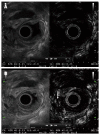Contrast-enhanced harmonic endoscopic ultrasound imaging: basic principles, present situation and future perspectives
- PMID: 25400439
- PMCID: PMC4229520
- DOI: 10.3748/wjg.v20.i42.15549
Contrast-enhanced harmonic endoscopic ultrasound imaging: basic principles, present situation and future perspectives
Abstract
Over the last decade, the development of stabilised microbubble contrast agents and improvements in available ultrasonic equipment, such as harmonic imaging, have enabled us to display microbubble enhancements on a greyscale with optimal contrast and spatial resolution. Recent technological advances made contrast harmonic technology available for endoscopic ultrasound (EUS) for the first time in 2008. Thus, the evaluation of microcirculation is now feasible with EUS, prompting the evolution of contrast-enhanced EUS from vascular imaging to images of the perfused tissue. Although the relevant experience is still preliminary, several reports have highlighted contrast-enhanced harmonic EUS (CH-EUS) as a promising noninvasive method to visualise and characterise lesions and to differentiate benign from malignant focal lesions. Even if histology remains the gold standard, the combination of CH-EUS and EUS fine needle aspiration (EUS-FNA) can not only render EUS more accurate but may also assist physicians in making decisions when EUS-FNA is inconclusive, increasing the yield of EUS-FNA by guiding the puncture with simultaneous imaging of the vascularity. The development of CH-EUS has also opened up exciting possibilities in other research areas, including monitoring responses to anticancer chemotherapy or to ethanol-induced pancreatic tissue ablation, anticancer therapies based on ultrasound-triggered drug and gene delivery, and therapeutic adjuvants by contrast ultrasound-induced apoptosis. Contrast harmonic imaging is gaining popularity because of its efficacy, simplicity and non-invasive nature, and many expectations are currently resting on this technique. If its potential is confirmed in the near future, contrast harmonic imaging will become a standard practice in EUS.
Keywords: Contrast agents; Contrast-enhanced harmonic endoscopic ultrasound; Gastrointestinal submucosal tumour; Microbubbles; Pancreatic tumour.
Figures














Similar articles
-
Contrast-enhanced endoscopic ultrasound.Dig Endosc. 2014 Jan;26 Suppl 1:79-85. doi: 10.1111/den.12179. Epub 2013 Sep 30. Dig Endosc. 2014. PMID: 24118242 Review.
-
Characterization of small solid tumors in the pancreas: the value of contrast-enhanced harmonic endoscopic ultrasonography.Am J Gastroenterol. 2012 Feb;107(2):303-10. doi: 10.1038/ajg.2011.354. Epub 2011 Oct 18. Am J Gastroenterol. 2012. PMID: 22008892
-
Contrast-enhanced harmonic endoscopic ultrasonography for assessment of lymph node metastases in pancreatobiliary carcinoma.World J Gastroenterol. 2016 Mar 28;22(12):3381-91. doi: 10.3748/wjg.v22.i12.3381. World J Gastroenterol. 2016. PMID: 27022220 Free PMC article.
-
New endoscopic ultrasound techniques for digestive tract diseases: A comprehensive review.World J Gastroenterol. 2015 Apr 28;21(16):4809-16. doi: 10.3748/wjg.v21.i16.4809. World J Gastroenterol. 2015. PMID: 25944994 Free PMC article. Review.
-
Contrast-enhanced harmonic endoscopic ultrasonography for pancreatobiliary diseases.Dig Endosc. 2015 Apr;27 Suppl 1:60-7. doi: 10.1111/den.12454. Dig Endosc. 2015. PMID: 25639788 Review.
Cited by
-
Advances in endoscopic ultrasound imaging of colorectal diseases.World J Gastroenterol. 2016 Feb 7;22(5):1756-66. doi: 10.3748/wjg.v22.i5.1756. World J Gastroenterol. 2016. PMID: 26855535 Free PMC article. Review.
-
Role of ultrasound in colorectal diseases.World J Gastroenterol. 2016 Nov 21;22(43):9477-9487. doi: 10.3748/wjg.v22.i43.9477. World J Gastroenterol. 2016. PMID: 27920469 Free PMC article. Review.
-
Diagnostics and Management of Pancreatic Cystic Lesions-New Techniques and Guidelines.J Clin Med. 2024 Aug 8;13(16):4644. doi: 10.3390/jcm13164644. J Clin Med. 2024. PMID: 39200786 Free PMC article. Review.
-
Gastric Cancer Angiogenesis Assessment by Dynamic Contrast Harmonic Imaging Endoscopic Ultrasound (CHI-EUS) and Immunohistochemical Analysis-A Feasibility Study.J Pers Med. 2022 Jun 21;12(7):1020. doi: 10.3390/jpm12071020. J Pers Med. 2022. PMID: 35887515 Free PMC article.
-
Enhanced endoscopic ultrasound imaging for pancreatic lesions: The road to artificial intelligence.World J Gastroenterol. 2022 Aug 7;28(29):3814-3824. doi: 10.3748/wjg.v28.i29.3814. World J Gastroenterol. 2022. PMID: 36157539 Free PMC article. Review.
References
-
- Wilson SR, Greenbaum LD, Goldberg BB. Contrast-enhanced ultrasound: what is the evidence and what are the obstacles? AJR Am J Roentgenol. 2009;193:55–60. - PubMed
-
- Kang ST, Yeh CK. Ultrasound microbubble contrast agents for diagnostic and therapeutic applications: current status and future design. Chang Gung Med J. 2012;35:125–139. - PubMed
-
- Kitano M, Kudo M, Sakamoto H, Komaki T. Endoscopic ultrasonography and contrast-enhanced endoscopic ultrasonography. Pancreatology. 2011;11 Suppl 2:28–33. - PubMed
-
- Săftoiu A, Dietrich CF, Vilmann P. Contrast-enhanced harmonic endoscopic ultrasound. Endoscopy. 2012;44:612–617. - PubMed
-
- Unnikrishnan S, Klibanov AL. Microbubbles as ultrasound contrast agents for molecular imaging: preparation and application. AJR Am J Roentgenol. 2012;199:292–299. - PubMed
Publication types
MeSH terms
Substances
LinkOut - more resources
Full Text Sources
Other Literature Sources
Medical

